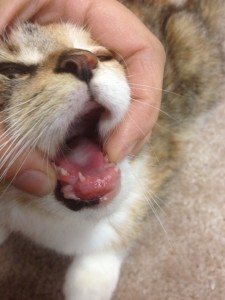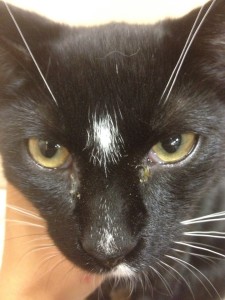
Calicivirus
Prevention is key! How? Vaccination! Because we have noticed an increase in the following cat diseases, we are raising vaccine awareness. Every pet’s immunization needs may vary according to the many different diseases prevalent in its environment and the relevance of those diseases to its individual wellness. Your veterinarian will help you evaluate these risks and address your pet’s Vaccination needs.
Immunosuppressive Diseases
- Feline Aids. The feline Immunodeficiency Virus (FIV) causes Feline AIDS in cats. It is not the same virus as the human immunodeficiency virus (HIV) which causes human AIDS. FIV causes AIDS-like symptoms in felines including immune system suppression and chronic susceptibility to other infections. Cats with FIV may remain apparently healthy for several years before their immune system becomes too weak to fight off other diseases. There is no cure for feline AIDS. Up to 1 in 3 cats in North America test positive for FIV. As with the Feline Leukemia virus, cat from multi-cat households and those that venture outdoors are at greatest risk of FIV infections.
- The Feline Leukemia Virus (FeLV): The Feline Leukemia Virus attacks the immune system and leaves the cat vulnerable to a host of secondary infections. Death most often occurs within 3-years of infection. Transmission usually occurs through contact with other cats. Those cats which live in multi-cat households or are allowed to roam outdoors are particularly at risk. There is no known relationship between FeLV and leukemia as it occurs in humans.
Gastrointestinal Diseases
- Panleukopenia: Panleukopenia or Feline Distemper is a widespread disease that is often fatal. Since most cats are likely to be exposed to panleukopenia in their lifetime, vaccination against this illness is of key importance. Clinical signs of panleukopenia include fever, depression, loss of appetite, vomiting and diarrhea.
- Giardia: Giardia is the most common waterborne parasite in North America. Virtually all mammals, including dogs, cats and humans, are susceptible to Giardia infection. Surface water contaminated by the fecal material of infected wildlife, birds and livestock are thought to be the primary source of this organism. Giardia can infect your pet when it comes in contact and drinks from contaminated puddles, ponds, ditches or streams. This protozoan parasite is very resistant to cold temperatures. Allergic symptoms in infected individuals has been associated with Giardia.
Contagious Respiratory Diseases
- Feline Viral Rhinotracheitis (FVR): FVR is the most common upper respiratory infection in cats. Clinical signs include moderate fever, appetite loss, sneezing, tearing, discharge from the eyes and nose, mouth breathing and coughing. Even if successfully treated, FVR can lead to a lifelong infection. Vaccination is extremely important.
- Feline Calicivirus (FCV): FCV is another virus that affects the feline upper respiratory system. It accounts for approximately 40% of all respiratory diseases in cats. The severity of the infection may vary, but symptoms most often include moderate fever, ulcers and blisters on the tongue. Even if successfully treated, cats infected with FCV can become chronic virus carriers with lifelong clinical signs of sneezing and runny eyes.
- Feline Chlamydiosis: Once known as “Feline Pneumonitis”, this disease causes a relatively mild upper respiratory infection, particularly affecting mucous membranes of the eyes. Symptoms include tearing and sometimes sneezing and nasal discharge.
Contagious Respiratory Diseases
-

Feline Viral Rhinotracheitis
Feline Viral Rhinotracheitis (FVR): FVR is the most common upper respiratory infection in cats. Clinical signs include moderate fever, appetite loss, sneezing, tearing, discharge from the eyes and nose, mouth breathing and coughing. Even if successfully treated, FVR can lead to a lifelong infection. Vaccination is extremely important.
- Feline Calicivirus (FCV): FCV is another virus that affects the feline upper respiratory system. It accounts for approximately 40% of all respiratory diseases in cats. The severity of the infection may vary, but symptoms most often include moderate fever, ulcers and blisters on the tongue. Even if successfully treated, cats infected with FCV can become chronic virus carriers with lifelong clinical signs of sneezing and runny eyes.
- Feline Chlamydiosis: Once known as “Feline Pneumonitis”, this disease causes a relatively mild upper respiratory infection, particularly affecting mucous membranes of the eyes. Symptoms include tearing and sometimes sneezing and nasal discharge.
